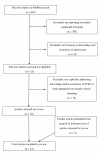Awareness and knowledge of sexually transmitted diseases (STDs) among school-going adolescents in Europe: a systematic review of published literature
- PMID: 21943100
- PMCID: PMC3189891
- DOI: 10.1186/1471-2458-11-727
Awareness and knowledge of sexually transmitted diseases (STDs) among school-going adolescents in Europe: a systematic review of published literature
Abstract
Background: Sexually transmitted diseases (STDs) are a major health problem affecting mostly young people, not only in developing, but also in developed countries.We conducted this systematic review to determine awareness and knowledge of school-going male and female adolescents in Europe of STDs and if possible, how they perceive their own risk of contracting an STD. Results of this review can help point out areas where STD risk communication for adolescents needs to be improved.
Methods: Using various combinations of the terms "STD", "HIV", "HPV", "Chlamydia", "Syphilis", "Gonorrhoea", "herpes", "hepatitis B", "knowledge", "awareness", and "adolescents", we searched for literature published in the PubMed database from 01.01.1990 up to 31.12.2010. Studies were selected if they reported on the awareness and/or knowledge of one or more STD among school-attending adolescents in a European country and were published in English or German. Reference lists of selected publications were screened for further publications of interest. Information from included studies was systematically extracted and evaluated.
Results: A total of 15 studies were included in the review. All were cross-sectional surveys conducted among school-attending adolescents aged 13 to 20 years. Generally, awareness and knowledge varied among the adolescents depending on gender.Six STDs were focussed on in the studies included in the review, with awareness and knowledge being assessed in depth mainly for HIV/AIDS and HPV, and to some extent for chlamydia. For syphilis, gonorrhoea and herpes only awareness was assessed. Awareness was generally high for HIV/AIDS (above 90%) and low for HPV (range 5.4%-66%). Despite knowing that use of condoms helps protect against contracting an STD, some adolescents still regard condoms primarily as an interim method of contraception before using the pill.
Conclusion: In general, the studies reported low levels of awareness and knowledge of sexually transmitted diseases, with the exception of HIV/AIDS. Although, as shown by some of the findings on condom use, knowledge does not always translate into behaviour change, adolescents' sex education is important for STD prevention, and the school setting plays an important role. Beyond HIV/AIDS, attention should be paid to infections such as chlamydia, gonorrhoea and syphilis.
Figures
References
-
- World Health Organisation. Global prevalence and incidence of selected curable sexually transmitted infections. WHO, Geneva; 2001.
-
- Berglund T, Fredlund H, Giesecke J. Epidemiology of the re-emergence of gonorrhoea in Sweden. Sex Transm Dis. 2001. pp. 111–114. - PubMed
-
- Health protection Surveillance Centre. Surveillance of STI. A report by the Sexually Transmitted Infections subcommittee for the Scientific Advisory committee of the health Protection Surveillance Centre. December 2005.
Publication types
MeSH terms
LinkOut - more resources
Full Text Sources
Medical
Research Materials


